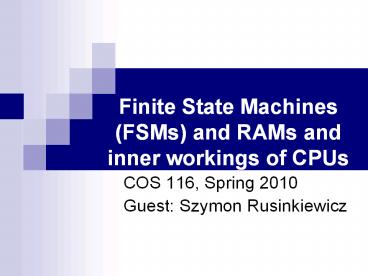Finite State Machines (FSMs) and RAMs and inner workings of CPUs - PowerPoint PPT Presentation
Title:
Finite State Machines (FSMs) and RAMs and inner workings of CPUs
Description:
Title: Creating new worlds inside the computer Author: David Xiao Last modified by: Adam Finkelstein Created Date: 2/15/2006 4:00:31 PM Document presentation format – PowerPoint PPT presentation
Number of Views:52
Avg rating:3.0/5.0
Title: Finite State Machines (FSMs) and RAMs and inner workings of CPUs
1
Finite State Machines (FSMs) and RAMs and inner
workings of CPUs
- COS 116, Spring 2010
- Guest Szymon Rusinkiewicz
2
Recap
- Combinational logic circuits no cycles, hence
no memory - Sequential circuits cycles allowed can have
memory as well as undefined/ambiguous
behavior - Clocked sequential circuits Contain D flip
flops whoseWrite input is controlled by a
clock signal
3
R-S Flip-Flop(corrected slide)
S
M
R
4
Recap D Flip Flop
- Basic Memory Block stores 1 bit.
If we toggle the write input (setting it 1 then
setting it 0) then M acquires the value of D.
5
Timing Diagram
5V
D
0V
Time
5V
W
0V
Time
5V
M
0V
Time
6
Finite State Machines (FSMs)
Detected Person
Automatic Door
No Person Detected
Closed
Open
Detected Person
No Person Detected
- Finite number of states
- Machine can produce outputs, these depend upon
current state only - Machine can accept one or more bits of input
reading these causes transitions among states.
7
What are some examples of FSMs?
How can we implement a FSM using logic gates etc.?
- If number of states 2k then represent state
by k boolean variables.
- Identify number of input variables
- Write truth table expressing how next state
is determined from current state and current
valuesof the input.
- Express as clocked synchronous circuit.
8
Example 4-state machine 1 bit of input No
output
State variables P, Q Input variable D
Next value of P (P Q) ? D Next value of Q P
What is its state diagram?
9
Implementation General Schematic
Inputs
K Flip flops allow FSM to have 2K states
10
Implementing door FSM as synchronous circuit
INPUT
0 No Person Detected 1 Person Detected
Input Present State Next State
0 0 0
1 0 1
0 1 0
1 1 1
STATE
0 Door Closed 1 Open
11
Implementation of door FSM (contd)
0 No Person Detected 1 Person Detected
INPUT
STATE
0 Door Closed 1 Open
CLOCK
12
Next.
Random Access Memory (RAM)
Memory where each location has an address
13
Recall from last lecture Register with 4 bits
of memory
How can youset up an addressingsystem for
large banks of memory?
14
RAM
RAM
RAM
Data
Data
K Address Bits
K Address Bits
Read
2K bitsbank offlipflops
Write
15
If 4 locations, address has 2 bits
Address
Clock
To RAMsClock input
16
RAM Implementing Write
RAM
Decoder (Demux)
Data
The decoder selects which cell in the RAM gets
its Write input toggled
Clock
(simple combinationalcircuit see logic handout)
K-bit address(in binary)
17
Ram implementing Read
RAM
Multiplexer
Data
The multiplexer is connected to all cells in the
RAM selects the appropriate cell based upon the
k-bit address
(simple combinationalcircuit see logic handout)
K-bit address(in binary)
18
Next, the secret revealed... How computers
execute programs.
CPU Central Processing Unit
19
Scribbler Control Panel Program
Machine Executable Code
F5
Download to Robot (Compilation)
Similar to
Point 1 Programs are translated into machine
language this iswhats get executed.
- T-P programs representedin binary
- .exe files in the Wintel world
20
Greatly simplified view of modern CPUs.
Program (in binary)stored in memory
Memory Registers
Arithmetic and Logic Unit(ALU)
Control FSM
Lots of Custom Hardware
Instruction Pointer
RAM
21
Examples of Machine Language Instructions
ADD 3 7 12 Add contents of Register 3 and Register 7 and store in Register 12
LOAD 3 67432 Read Location 67432 from memory and load into Register 3
JUMP 4 35876 If register 4 has a number gt 0 set IP to 35876
Stored in binary (recall Daviss binary encoding
of T-P programs)
22
Different CPUs have different machine languages
- Intel Pentium, Core, Xeon, etc. (PC, recent Mac)
- Power PC (old Mac)
- ARM (cellphones, mobile devices, etc.)
- Backwards Compatibility Core 2s machine
language extends Pentiums machine
languageMachine languages now allow
complicated calculations (eg for multimedia,
graphics) in a single instruction
23
Main Insight
- Computer FSM controlling a larger (or infinite)
memory.
24
Meet the little green man
- The Fetch Decode Execute FSM
25
Fetch Decode Execute FSM
ADD Instruction
IP IP 1
Fetch
JUMP Instruction
Go to nextinstruction
Execute
Decode
26
CPU as a conductor of a symphony
Sound Card
Network Card
CPU
BUS e.g., PCI
CD-ROM
Video Card
Bus Everybody hears everybody else
27
How an FSM does reasoning
- If left infrared sensor detects a person, turn
left
28
Speculation Brain as FSM?
- Network (graph) of 100 billion neurons each
connected to a few thousand others - Neuron tiny Computational Element
switching time 0.01 s - Neuron generates a voltage spike depending upon
how many neighbors are spiking.































